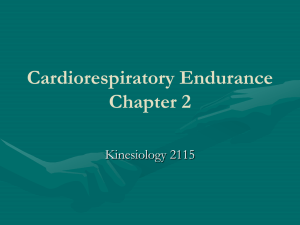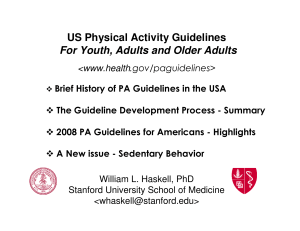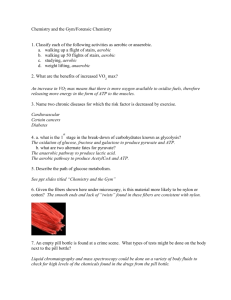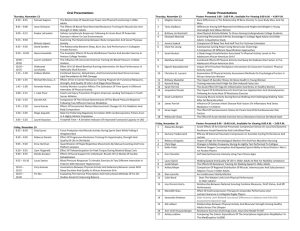WHICH COMES FIRST? RESISTANCE BEFORE AEROBIC
advertisement
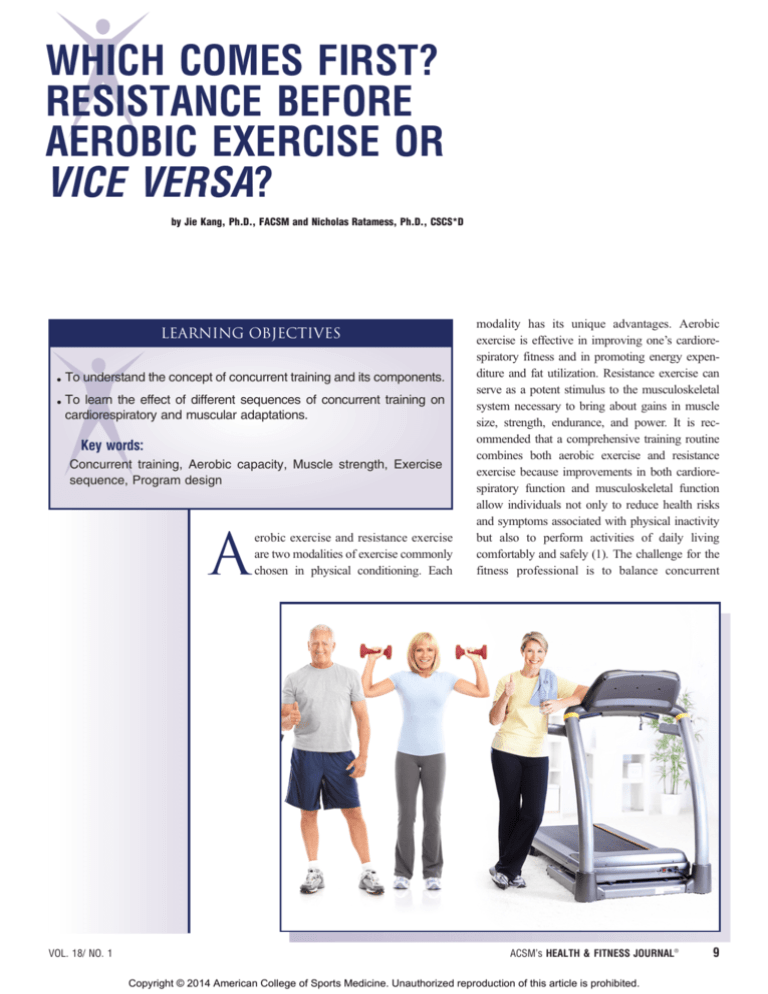
WHICH COMES FIRST? RESISTANCE BEFORE AEROBIC EXERCISE OR VICE VERSA? by Jie Kang, Ph.D., FACSM and Nicholas Ratamess, Ph.D., CSCS*D LEARNING OBJECTIVES • To understand the concept of concurrent training and its components. • To learn the effect of different sequences of concurrent training on cardiorespiratory and muscular adaptations. Key words: Concurrent training, Aerobic capacity, Muscle strength, Exercise sequence, Program design A VOL. 18/ NO. 1 erobic exercise and resistance exercise are two modalities of exercise commonly chosen in physical conditioning. Each modality has its unique advantages. Aerobic exercise is effective in improving one’s cardiorespiratory fitness and in promoting energy expenditure and fat utilization. Resistance exercise can serve as a potent stimulus to the musculoskeletal system necessary to bring about gains in muscle size, strength, endurance, and power. It is recommended that a comprehensive training routine combines both aerobic exercise and resistance exercise because improvements in both cardiorespiratory function and musculoskeletal function allow individuals not only to reduce health risks and symptoms associated with physical inactivity but also to perform activities of daily living comfortably and safely (1). The challenge for the fitness professional is to balance concurrent ACSM’s HEALTH & FITNESS JOURNALA Copyright © 2014 American College of Sports Medicine. Unauthorized reproduction of this article is prohibited. 9 Which Comes First-Resistance Before Aerobic Exercise? aerobic training and resistance training properly to maximize the performance benefits of both modalities. CONCURRENT AEROBIC TRAINING AND RESISTANCE TRAINING Concurrent aerobic training and resistance training can be performed: 1) simultaneously during the same workout; 2) in 1 day using a split workout format, that is, aerobic exercise in the morning, resistance exercise in the evening; 3) during separate workouts on different days, that is, resistance exercise on Monday, aerobic exercise on Tuesday, and so on; and 4) during specific training cycles. Simultaneous concurrent training is popular and requires the participant or trainer to decide the sequence of aerobic and resistance exercises and/or if both modalities will be combined, that is, aerobic exercise is performed in-between sets of resistance exercise. Concurrent aerobic training and resistance training have the potential to bring about gains in cardiorespiratory and muscular fitness simultaneously. This training format also has been used by athletes who train for sports that demand both aerobic and anaerobic capabilities. However, this type of training should be carried out with caution and may require the trainer to prioritize one or the other based on training goals. The combination of high-intensity endurance and resistance training has been shown to compromise maximal development of muscle strength and power (8,16). The impeded gains in strength and power may be attributable to the fact that a few of these studies have used more frequent training sessions (e.g., 6 days per week) coupled with high intensity or high volume, which could have reduced recovery time in-between workouts primarily in lower-body musculature. When concurrent training programs were performed on the same day and the number of training days per week is reduced, gains in strength, power, or aerobic capacity do not seem to be compromised (4,10,13,18). Concurrent training seems to produce little or no ‘‘interference’’ in older individuals. In fact, a combination of aerobic training and resistance training is recommended for the elderly as an effective strategy to maintain functional capacity and promote health (6). Recent studies on elderly individuals (Q65 years old) have demonstrated similar improvement in cardiorespiratory fitness and muscular strength after single-mode and concurrent training (2,14,22). The concurrent training protocols used by these studies were less frequent (e.g., e3 times per week) and intense (e.g., È50% of one repetition-maximum (1-RM)) but balanced for a moderate training volume. It is conceivable that if the goal of a concurrent training program is to enhance fitness and promote health, the likelihood of overtraining and residual fatigue will be minimized. when performed simultaneously within a workout. Should resistance exercise be performed before aerobic exercise or should aerobic exercise be performed before resistance exercise? This is an important question in that the residual fatigue caused by the previous modality can interfere with performance of the subsequent modality, thereby reducing overall quality of training. At present, there is no consensus as to which exercise sequence is more effective, but sequencing recommendations are dependent on the program priorities. In addition, a trainer may choose to alternate sequences between workouts to allow each modality to be prioritized every other workout. Most studies that have compared the efficacy of two exercise orders generally suggest that the intrasession sequence of training produces no significant differences in training-induced adaptations between groups because both combinations allow similar improvements in cardiorespiratory and muscular fitness. However, some of these studies also have indicated that each training sequence could have its own unique advantages and drawbacks that one should consider to pursue concurrent training more effectively. Cardio Training Before Resistance Training Chtara et al. (4) reported that placing aerobic training before resistance training could improve running performance and V̇O2max to a greater extent than the reverse order. In this study, aerobic training was carried out by having subjects run at a velocity corresponding to their V̇O2max intermittently, whereas resistance training was administered via a circuit training protocol. Although both orders of training produced significant improvements in V̇O2max, the improvement was greater in the endurance training-first group than the resistance training-first group. Drummond et al. (7) found that the aerobic-first sequence was more effective in augmenting excess postexercise oxygen consumption (EPOC). In this study, the aerobic session involved continuous running at a pace that corresponded to 70% V̇O2max for 25 minutes, whereas resistance training session consisted of three sets of 10 repetitions at 70% of 1-RM for each of the eight exercises. Interestingly, despite a greater EPOC found DOES EXERCISE SEQUENCE OF SIMULTANEOUS CONCURRENT TRAINING MATTER? A unique perspective of concurrent training is the order in which aerobic and resistance exercise sessions are presented 10 ACSM’s HEALTH & FITNESS JOURNALA | www.acsm-healthfitness.org Copyright © 2014 American College of Sports Medicine. Unauthorized reproduction of this article is prohibited. VOL. 18/ NO. 1 of exercise. Using concurrent training in which subjects were prescribed to exercise on a cycle ergometer either continuously at 70% V̇O2max or intermittently at 95% to 100% V̇O2max, Sporer and Wenger (21) found that the volume in total repetitions over four sets of leg press performed after the aerobic session was reduced significantly until after 8 hours of recovery. However, this reduction in strength performance was not observed during bench press. Resistance Training Before Cardio Training with the run-first protocol, V̇O2 during the run was significantly lower and this could suggest that the total energy expenditure that combines exercise and recovery may be comparable between the two exercise sequences. Davis et al. (5) used a ‘‘cardio acceleration’’ protocol in which subjects were asked to run for up to a minute at 60% to 84% of heart rate reserve immediately before each set of resistance exercise that was performed at 50% to 65% of 1-RM. They found that this cardio-first sequence was able to eliminate the delayed-onset muscle soreness by the fourth week of training. Authors attributed this positive effect to the elevated heart rate caused by previous aerobic bouts that may have, in turn, increased blood flow to the working muscle during each subsequent set of resistance exercise. A potential drawback of the aerobic-first sequence is that aerobic training if performed vigorously can compromise the performance of subsequent resistance exercise, thereby attenuating strength and power development during concurrent training (8,16,17). It is believed that residual fatigue from the endurance component of concurrent training can reduce the tension developed during the strength element of concurrent training. Such a compromise in strength gain is consistent with a recent report by Goto et al. (11) who found that a previous prolonged (È1 hour) endurance exercise session at 50% V̇O2max attenuated the acute growth hormone response to subsequent resistance exercise. This finding suggests that to produce more favorable hormonal responses, resistance exercise session may have to be performed alone or placed before the aerobic session when these two types of exercise are combined. The reduced performance of resistance exercise as a result of a previous aerobic exercise also can be ascribed to the fact that the same muscle groups were used during both modes VOL. 18/ NO. 1 It seems that the resistance exercise-first sequence would favor gains in muscle strength, power, and size because of the absence of preexercise fatigue resulting from aerobic exercise. This sequence may be of particular interest to athletes whose sports demand strength and power. By placing strength sessions before the endurance sessions or, when not feasible, separating both types of training by at least 6 hours to allow for sufficient recovery, Garcı́a-Pallarés et al. (9) demonstrated that highly trained kayakers achieved significant improvements in muscle strength and power as well as aerobic capacity. It is worth noting that training protocols used in this study involved only the upper-body musculature. Most studies demonstrating an incompatibility between aerobic and resistance training used lower-body exercises. The resistance exercise-first sequence also seems more effective in enhancing aerobic power in the elderly and women. Cadore et al. (3) found that, in the elderly, performance of resistance training before or after aerobic training yielded similar gains in V̇O2peak and muscular strength, but the resistance training-first group demonstrated greater improvement in maximal workload achieved at V̇O2peak. It seems that, by emphasizing the strength element of concurrent training, the elderly may experience a greater gain in aerobic capacity because their V̇O2max is largely limited by the aging-related loss of muscle mass and strength. In this study, subjects undertook a periodized concurrent training program 3 times a week for 12 weeks and the average intensities used for aerobic and resistance training were 70% V̇O2peak and 40% of 1-RM, respectively. By assigning women into concurrent training of different sequences, Gravelle and Blessing (13) found that an improvement in V̇O2max occurred only in subjects who performed resistance training before aerobic training. In this study, women participated in a progressive concurrent training program 3 times a week for 11 weeks, and initial workloads for aerobic and resistance training corresponded to 70% V̇O2max for 25 minutes and 2 sets of 10-RM on each of 7 exercises, respectively. The resistance exercise-first sequence seems to affect metabolism during the subsequent aerobic session favorably. Kang et al. (15) recently demonstrated that fat oxidation and energy expenditure were augmented during aerobic exercise that was preceded by a multiset resistance exercise protocol, and this effect was more pronounced when resistance exercise was performed at a higher intensity (e.g., È90% of 8-RM vs. 60% of 8-RM). Using a similar research paradigm, Goto et al. ACSM’s HEALTH & FITNESS JOURNALA Copyright © 2014 American College of Sports Medicine. Unauthorized reproduction of this article is prohibited. 11 Which Comes First-Resistance Before Aerobic Exercise? (12) found that serum concentrations of fatty acids, glycerol, and growth hormone were higher at the onset of aerobic exercise that was preceded by a resistance exercise session as compared with aerobic exercise alone. Hence, the greater fat oxidation seen in the resistance-first sequence could be ascribed to an increased lipolysis that was brought about by the preceding resistance exercise. Summary It seems that concurrent training of either resistance training before aerobic training or aerobic training before resistance training can elicit both aerobic and anaerobic adaptations simultaneously provided that the training program is carefully designed. However, there are some unique advantages associated with each exercise sequence. Performing aerobic exercise first may be a preferred choice for developing maximal aerobic power. This exercise sequence also has been shown to enhance postexercise energy expenditure. The preceding aerobic session of high intensity or long duration may compromise the quality of subsequent resistance exercise. However, one can avoid this potential interference by allowing more time for recovery and/or by training different muscle groups between two exercise sessions. On the other hand, resistance exercise first seems more favorable for developing strength, power, and muscle hypertrophy. This modality sequence also seems more effective in enhancing maximal aerobic power in the elderly whose V̇O2max is limited in part by the aging-related loss of muscle mass and strength. Resistance exercise first also can yield some metabolic benefits, and the high-intensity nature of resistance exercise can potentiate energy expenditure and create a metabolic environment that favors fat utilization during a subsequent aerobic session. PROGRAM DESIGN The design of a concurrent training program should consider common acute program variables, including exercise selection and sequence, intensity and volume, frequency, repetition velocity, and rest intervals, and these variables should be determined based on goals, expected outcomes, and training status of participants (1,19,20). Specific guidelines for aerobic training (1) and resistance training (20) have been published by ACSM. The unique element to concurrent training is designing programs that target multiple fitness components TABLE 1: A 12-Week Concurrent Training Program Weeks Aerobic Training Session Resistance Training Session Weeks 1 to 2 20 minutes at 60% V̇O2max or HRR* on activities that involve large muscle groups Rest (5 to 10 minutes) 3 sets of 10 to 12 reps (60% to 70% of 1-RM) on each of 6 to 10, 1- to 2-minute rest intervals, multiple- and single-joint exercises that stress all major muscle groups sequenced from large to small muscle groups, multiple- to single-joint exercises, and higher- to lower-intensity exercises Weeks 3 to 4 20 minutes at 60% V̇O2max or HRR on activities that involve large muscle groups Rest (5 to 10 minutes) 3 sets of 10 to 12 reps (60% to 70% of 1-RM) on each of 6 to 10, 1- to 2-minute rest intervals, multiple- and single-joint exercises that stress all major muscle groups sequenced from large to small muscle groups, multiple- to single-joint exercises, and higher- to lower-intensity exercises Weeks 5 to 6 25 minutes at 65% V̇O2max or HRR on activities that involve large muscle groups Rest (5 to 10 minutes) 3 sets of 10 to 12 reps (65% to 75% of 1-RM) on each of 6 to 10, 1- to 2-minute rest intervals, multiple- and single-joint exercises that stress all major muscle groups sequenced from large to small muscle groups, multiple- to single-joint exercises, and higher- to lower-intensity exercises Weeks 7 to 8 25 minutes at 65% V̇O2max or HRR on activities that involve large muscle groups Rest (5 to 10 minutes) 3 sets of 10 to 12 reps (65% to 75% of 1-RM) on each of 6 to 10, 1- to 2-minute rest intervals, multiple- and single-joint exercises that stress all major muscle groups sequenced from large to small muscle groups, multiple- to single-joint exercises, and higher- to lower-intensity exercises Weeks 9 to 10 30 minutes at 70% V̇O2max or HRR on activities that involve large muscle groups Rest (5 to 10 minutes) 3 sets of 8 to 10 reps (70% to 80% of 1-RM) on each of 6 to 10, 1- to 2-minute rest intervals, multiple- and single-joint exercises that stress all major muscle groups sequenced from large to small muscle groups, multiple- to single-joint exercises, and higher- to lower-intensity exercises Weeks 11 to 12 30 minutes at 70% V̇O2max or HRR on activities that involve large muscle groups Rest (5 to 10 minutes) 3 sets of 8 to 10 reps (70% to 80% of 1-RM) on each of 6 to 10, 1- to 2-minute rest intervals, multiple- and single-joint exercises that stress all major muscle groups sequenced from large to small muscle groups, multiple- to single-joint exercises, and higher- to lower-intensity exercises * Heart rate reserve (HRR) that can be obtained by subtracting resting heart rate from age-predicted maximal heart rate. 12 ACSM’s HEALTH & FITNESS JOURNALA | www.acsm-healthfitness.org Copyright © 2014 American College of Sports Medicine. Unauthorized reproduction of this article is prohibited. VOL. 18/ NO. 1 while minimizing potential incompatibility. This will require special considerations. If all variables are considered carefully, then concurrent training can be a time-efficient way of eliciting a wide range of physiological adaptations simultaneously. For healthy individuals, it is recommended that moderate intensities be used coupled with moderate volume for both modes of exercise regardless of exercise sequence. For example, one may choose an intensity of 60% to 70% V̇O2max coupled with exercise duration of 25 to 30 minutes for the aerobic portion (1) and 3 to 4 sets of 8 to 12 repetitions using 60% to 80% of 1-RM with 1- to 2-minute rest intervals or more featuring 6 to 10 exercises for the resistance exercise portion (20). Exercise selection may include single- and multiple-joint free weight and machine exercises (performed bilaterally and unilaterally), corrective exercises, combination exercises, power exercises, and exercises with implements and instability equipment. Sequencing strategies may vary especially if one is training to enhance muscle endurance, but basic ACSM guidelines of large to small muscle groups, multiple- to single-joint exercises, and heavier to lighter exercise sequences will apply (19,20). One should expect little to no interference between the two modes of exercise, and the entire training session can be completed within 60 to 90 minutes. These choices of intensity and volume are consistent with those used in studies that showed significant gains in both cardiorespiratory fitness and muscular fitness. Concurrent training may be administered approximately 3 to 4 times per week on nonconsecutive days (to maximize recovery in-between workouts), and the 2 exercise sessions may be separated by a rest period of 5 to 10 minutes. For those who pursue concurrent training more vigorously, a longer recovery period up to several hours may be necessary. As shown in most studies, a training cycle that lasts 11 to 12 weeks is necessary to manifest the training-induced aerobic and anaerobic adaptations. The Table illustrates a 12-week concurrent training program in which workloads of both aerobic training and resistance training increase progressively. The order of aerobic and resistance training sessions can be reversed depending on the goal of the program. For example, endurance athletes (i.e., crosscountry runners and road cyclists) or those who seek to improve their aerobic power may consider pursuing the aerobic-first sequence. This will then ensure the quality of their aerobic training. On the other hand, athletes competing for events that demand strength and power (i.e., 100-m sprint, football, and baseball) or those who train for muscle hypertrophy may choose to use the resistance exercise-first sequence for the same reason. This illustration does not include the warm-up and cooldown periods that should be carried out in each training session. CONCLUSIONS Concurrent training of either resistance exercise before aerobic exercise or aerobic exercise before resistance exercise can confer VOL. 18/ NO. 1 both aerobic and anaerobic benefits simultaneously provided that the training program is designed and carried out properly. However, there are some unique advantages and disadvantages associated with each exercise sequence that one should consider to optimize one’s training outcomes. References 1. American College of Sports Medicine. Quantity and quality of exercise for developing and maintaining cardiorespiratory, musculoskeletal, and neuromotor fitness in apparently healthy adults: Guidance for prescribing exercise. Med Sci Sports Exerc. 2011;26:1334Y59. 2. Cadore EL, Izquierdo M, Alberton CL, Pinto RS, Conceição M, Cunha G, Radaelli R, Bottaro M, Trindade GT, Kruel LF. Strength prior to endurance intra-session exercise sequence optimizes neuromuscular and cardiovascular gains in elderly men. Exp Gerontol. 2012;47(2):164Y9. 3. Cadore EL, Pinto RS, Pinto SS, Alberton CL, Correa CS, Tartaruga MP, Silva EM, Almeida AP, Trindade GT, Kruel LF. Effects of strength, endurance, and concurrent training on aerobic power and dynamic neuromuscular economy in elderly men. J Strength Cond Res. 2011;25(3):758Y66. 4. Chtara M, Chamari K, Chaouachi M, Chaouachi A, Koubaa D, Feki Y, Millet GP, Amri M. Effects of intra-session concurrent endurance and strength training sequence on aerobic performance and capacity. Br J Sports Med. 2005;39(8):555Y60. 5. Davis WJ, Wood DT, Andrews RG, Elkind LM, Davis WB. Elimination of delayed-onset muscle soreness by pre-resistance cardio acceleration before each set. J Strength Cond Res. 2008;22(1):212Y25. 6. Donnelly JE, Blair SN, Jakicic JM, Manore MM, Rankin JW, Smith BK, ; American College of Sports Medicine. American College of Sports Medicine Position Stand. Appropriate physical activity intervention strategies for weight loss and prevention of weight regain for adults. Med Sci Sports Exerc. 2009;41(2):459Y71. 7. Drummond MJ, Vehrs PR, Schaalje GB, Parcell AC. Aerobic and resistance exercise sequence affects excess postexercise oxygen consumption. J Strength Cond Res. 2005;19(2):332Y7. 8. Dudley GA, Djamil R. Incompatibility of endurance- and strength-training modes of exercise. J Appl Physiol. 1985;59(5):1446Y51. 9. Garcı́a-Pallarés J, Sánchez-Medina L, Carrasco L, Dı́az A, Izquierdo M. Endurance and neuromuscular changes in world-class level kayakers during a periodized training cycle. Eur J Appl Physiol. 2009;106(4):629Y38. 10. Glowacki SP, Martin SE, Maurer A, Baek W, Green JS, Crouse SF. Effects of resistance, endurance, and concurrent exercise on training outcomes in men. Med Sci Sports Exerc. 2004;36(12):2119Y27. 11. Goto K, Higashiyama M, Ishii N, Takamatsu K. Prior endurance exercise attenuates growth hormone response to subsequent resistance exercise. Eur J Appl Physiol. 2005;94(3):333Y8. 12. Goto K, Ishii N, Sugihara S, Yoshioka T, Takamatsu K. Effects of resistance exercise on lipolysis during subsequent submaximal exercise. Med Sci Sports Exerc. 2007;39(2):308Y15. 13. Gravelle BL, Blessing DL. Physiological adaptations in women concurrently training for strength and endurance. J Strength Cond Res. 2000;14(1):5Y13. 14. Izquierdo M, Ibañez J, Häkkinen K, Kraemer WJ, Larrión JL, Gorostiaga EM. Once weekly combined resistance and cardiovascular training in healthy older men. Med Sci Sports Exerc. 2004;36(3):435Y43. 15. Kang J, Rashti SL, Tranchina CP, Ratamess NA, Faigenbaum AD, Hoffman JR. Effect of preceding resistance exercise on metabolism during subsequent aerobic session. Eur J Apple Physiol. 2009;107(1): 43Y50. ACSM’s HEALTH & FITNESS JOURNALA Copyright © 2014 American College of Sports Medicine. Unauthorized reproduction of this article is prohibited. 13 Which Comes First-Resistance Before Aerobic Exercise? 16. Kraemer WJ, Patton JF, Gordon SE, Harman EA, Deschenes MR, Reynolds K, Newton RU, Triplett NT, Dziados JE. Compatibility of high-intensity strength and endurance training on hormonal and skeletal muscle adaptations. J Appl Physiol. 1995;78(3):976Y89. 17. Leveritt M, Abernethy PJ. Acute effects of high intensity endurance exercise on subsequent resistance activity. J Strength Cond Res. 1999;13(1):47Y51. 18. McCarthy JP, Agre JC, Graf BK, Pozniak MA, Vailas AC. Compatibility of adaptive responses with combining strength and endurance training. Med Sci Sports Exerc. 1995;27(3):429Y36. 19. Ratamess N. Resistance training program design. In: Ratamess N. ACSM Foundations of Strength Training and Conditioning. Philadelphia (PA): Lippincott Williams & Wilkins; 2012. p. 192Y228. 20. Ratamess NA, Alvar BA, Evetovich TK, Housh TJ, Kibler WB, Kraemer WJ, Triplett NT. American College of Sports Medicine position stand: Progression models in resistance training for healthy adults. Med Sci Sports Exerc. 2009;41(3):687Y708. Nicholas Ratamess, Ph.D., CSCS*D, is an associate professor in the Department of Health and Exercise Science, The College of New Jersey. His research interests are strength training and conditioning, physiological adaptations, and sports supplementation. He is the author of ACSM’s Foundations of Strength Training and Conditioning, coauthor of the ACSM’s position stand on ‘‘Progression Models in Resistance Training for Healthy Adults,’’ and a senior editor of the Journal of Strength and Conditioning Research. 21. Sporer BC, Wenger HA. Effects of aerobic exercise on strength performance following various periods of recovery. J Strength Cond Res. 2003;17(4):638Y44. 22. Takeshima N, Rogers ME, Islam MM, Yamauchi T, Watanabe E, Okada A. Effect of concurrent aerobic and resistance circuit exercise training on fitness in older adults. Eur J Appl Physiol. 2004;93(1Y2):173Y82. Disclosure: The authors declare no conflicts of interest and do not have any financial disclosures. Jie Kang, Ph.D., FACSM, is a professor in the Department of Health and Exercise Science, The College of New Jersey. His research interests relate to alterations in energy metabolism, substrate utilization, cardiorespiratory function, and perceived exertion in response to both acute and chronic exercise. He is the author of Bioenergetics Primer for Exercise Science and Nutrition and Metabolism in Sports, Exercise, and Health. 14 CONDENSED VERSION AND BOTTOM LINE Concurrent training of either resistance exercise before aerobic or aerobic before resistance exercise can be a time-efficient way of eliciting various physiological adaptations simultaneously. However, there are some unique advantages associated with each exercise sequence. Performing aerobic exercise first may be preferable for developing aerobic power. This exercise sequence also can enhance post-exercise energy expenditure. On the other hand, performing resistance exercise first is more favorable for developing strength, power, and muscle hypertrophy. This exercise sequence is also more effective in enhancing aerobic capacity in the elderly and can augment energy expenditure and fat utilization during a subsequent aerobic session. ACSM’s HEALTH & FITNESS JOURNALA | www.acsm-healthfitness.org Copyright © 2014 American College of Sports Medicine. Unauthorized reproduction of this article is prohibited. VOL. 18/ NO. 1


